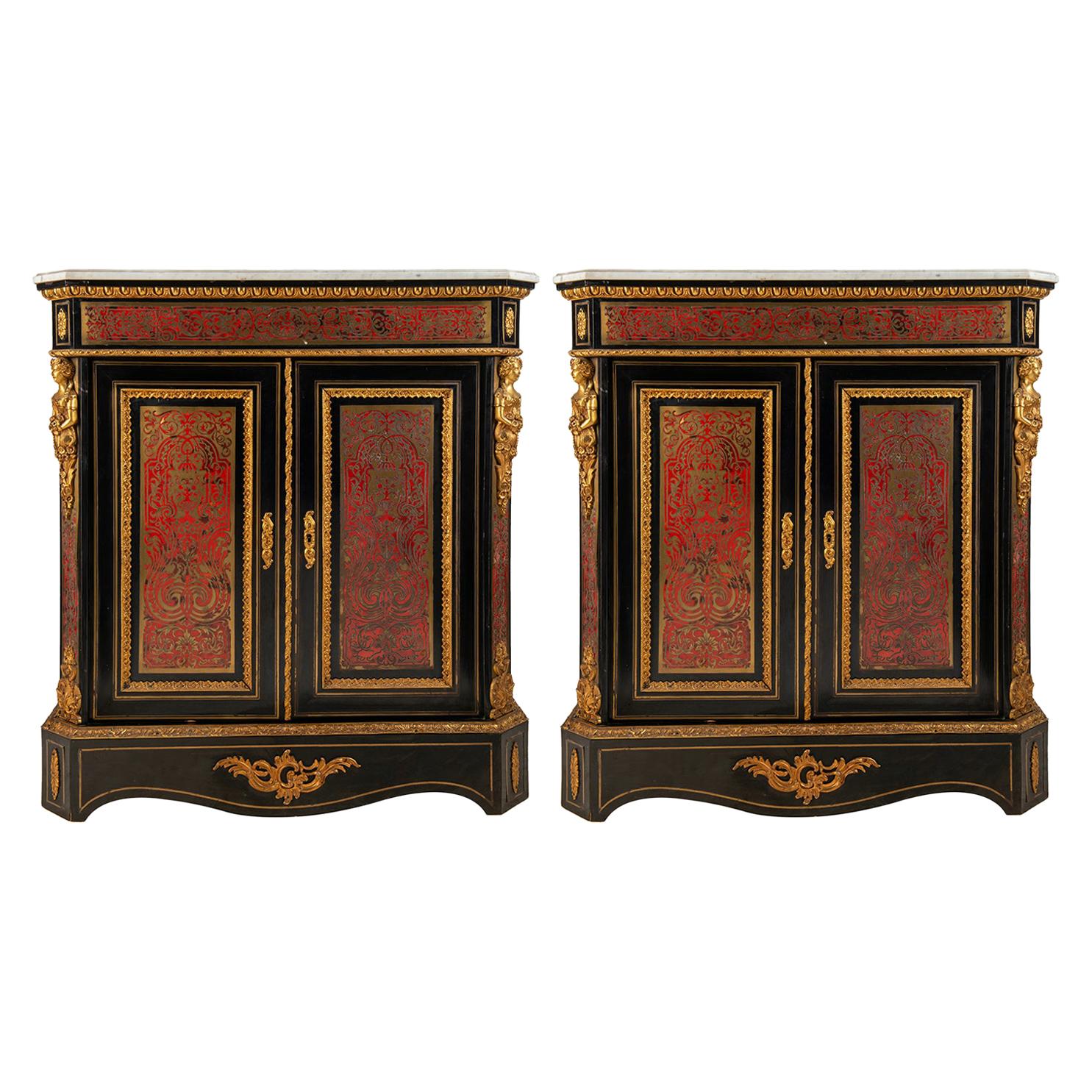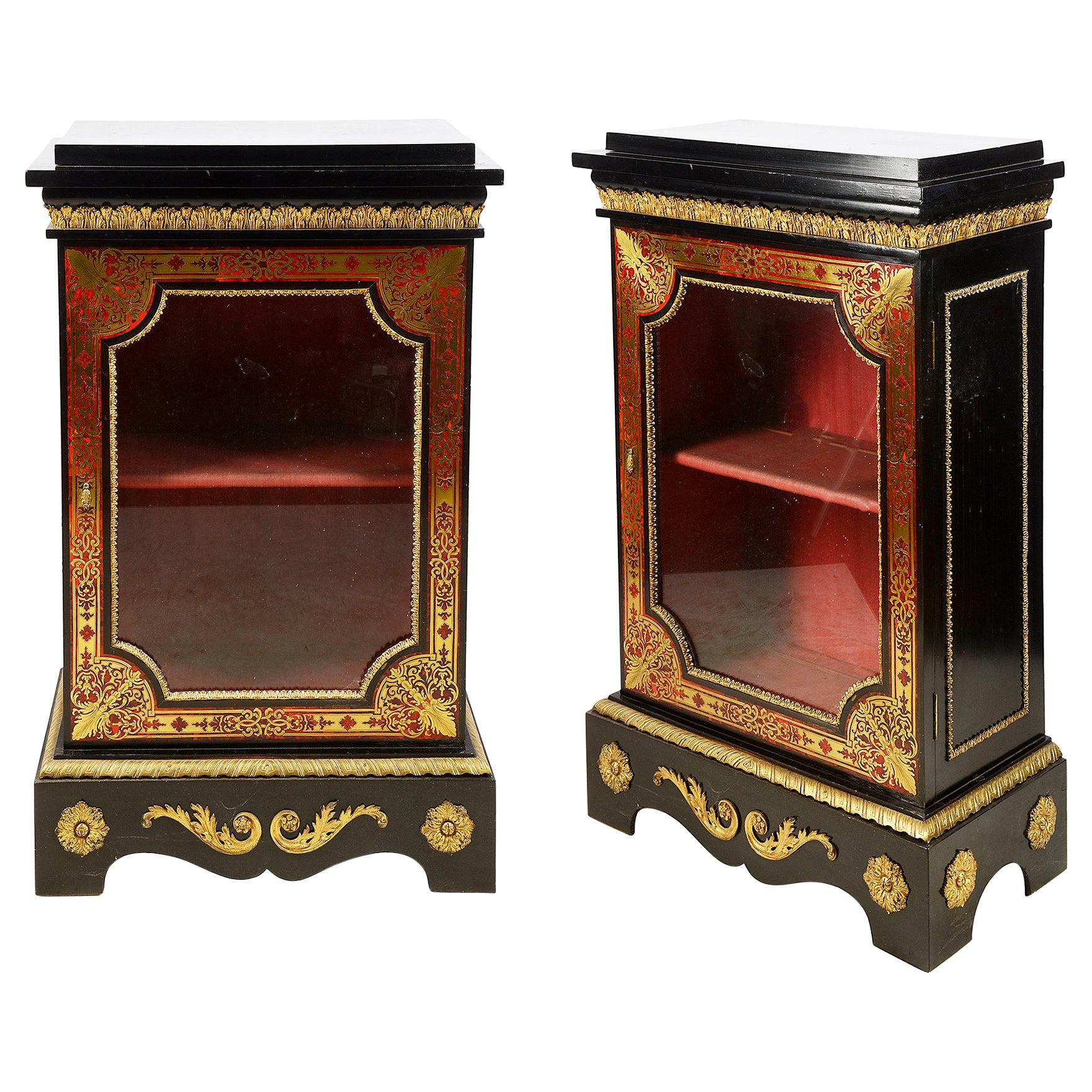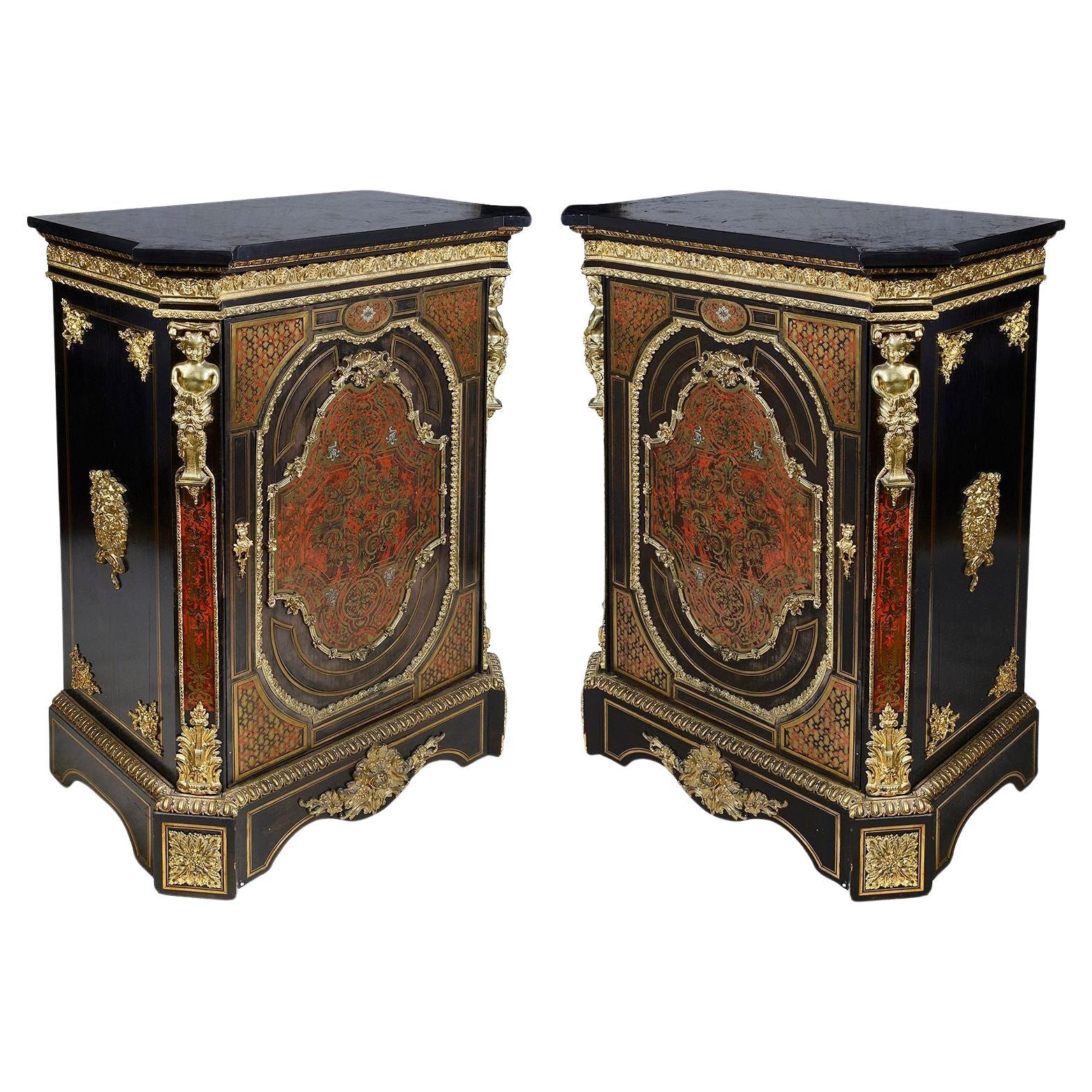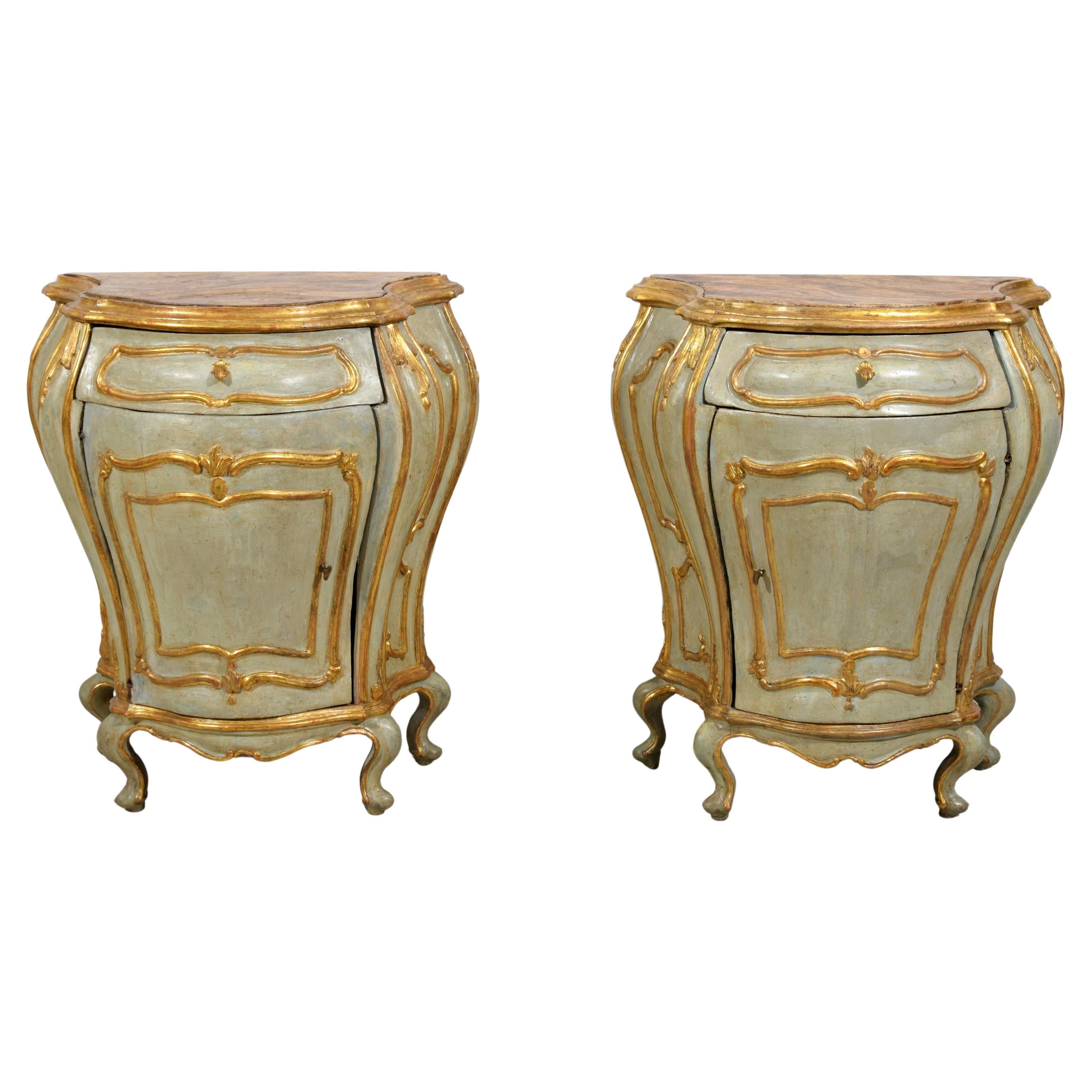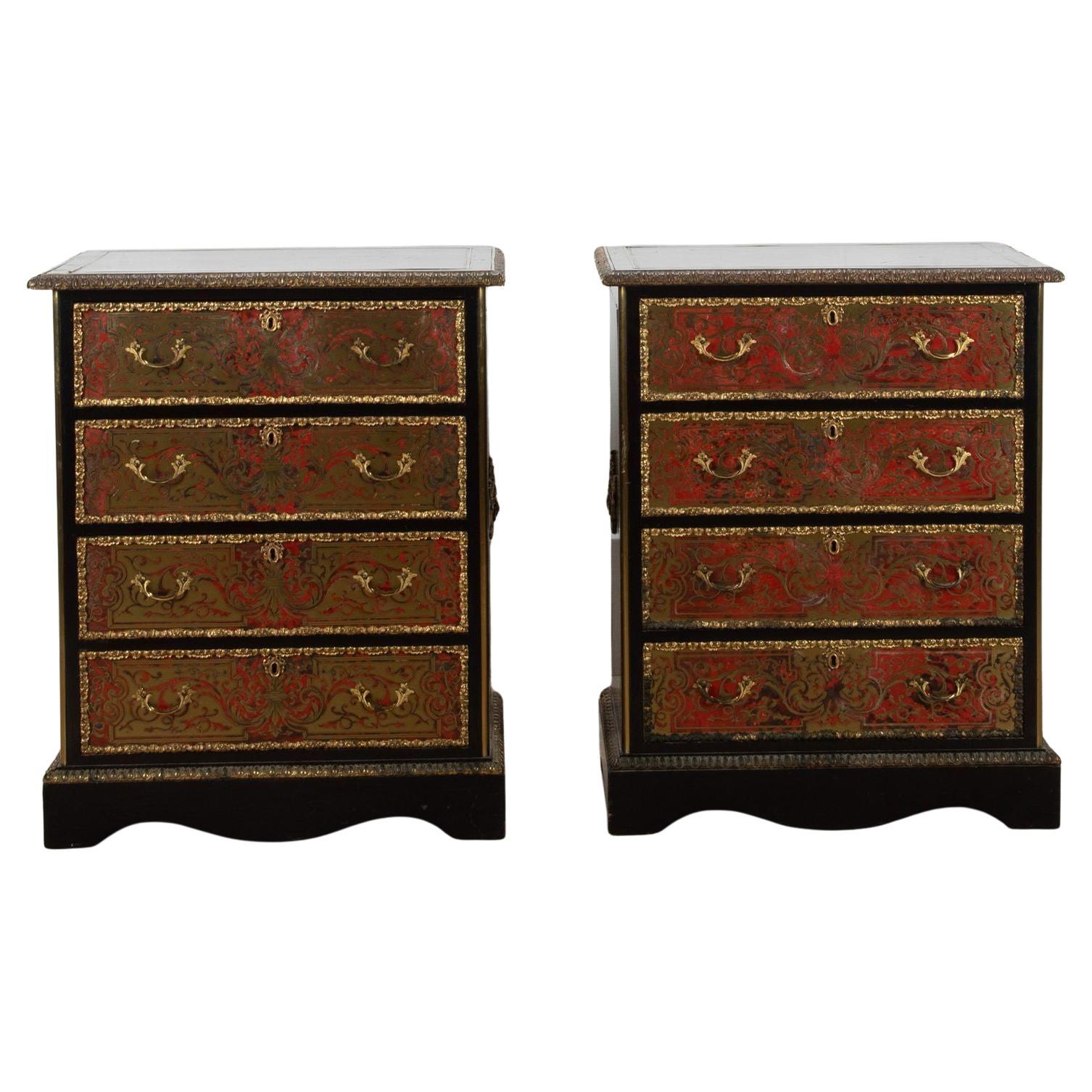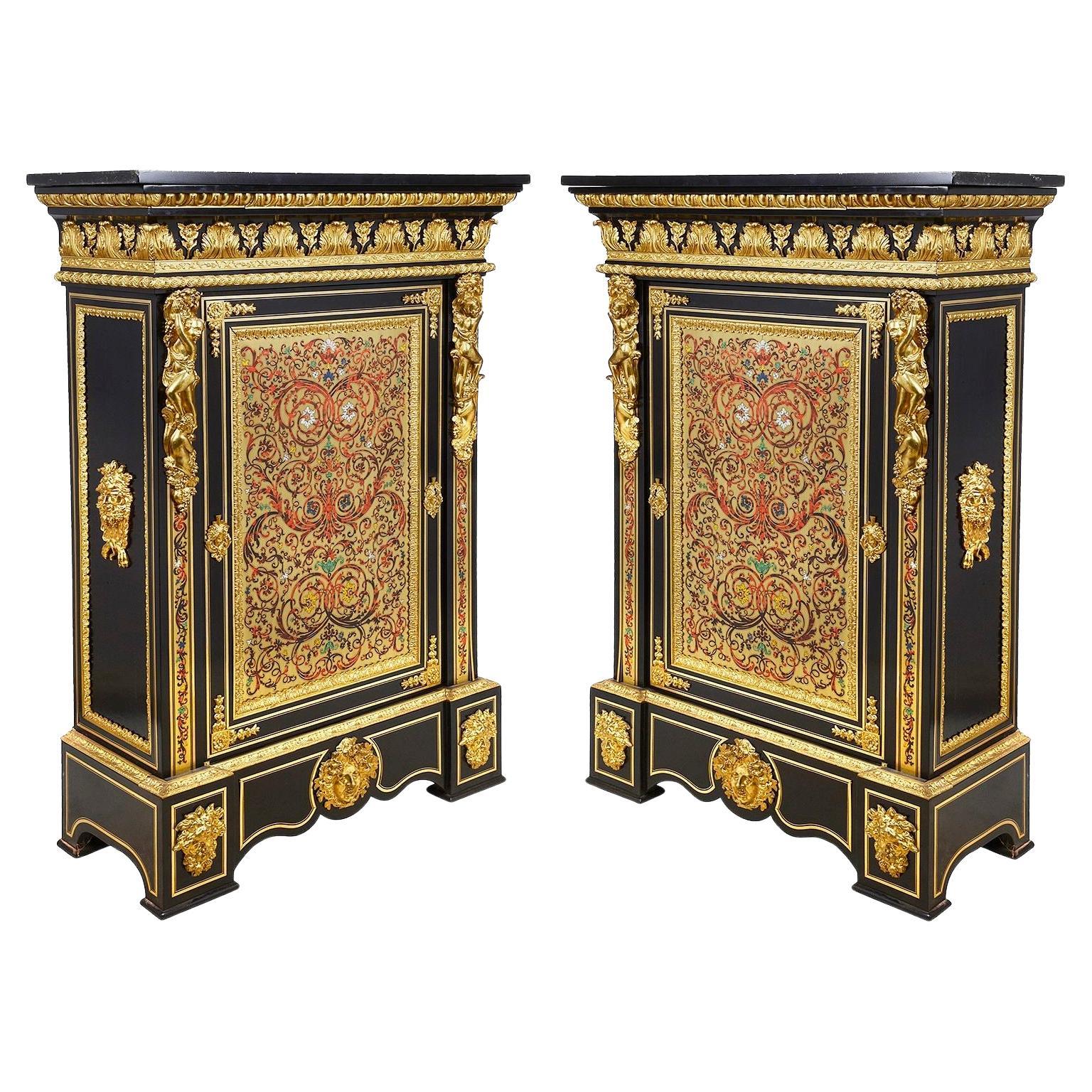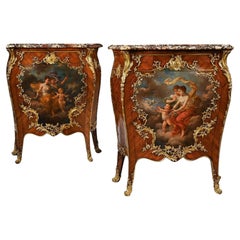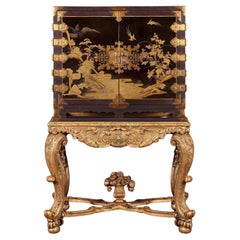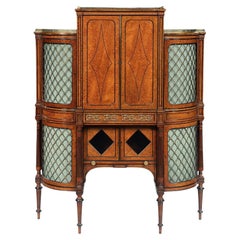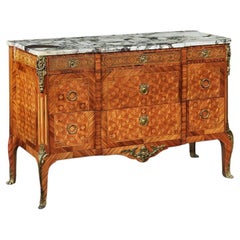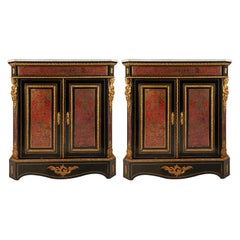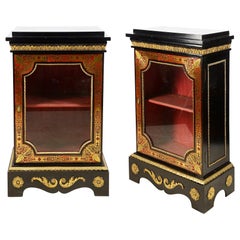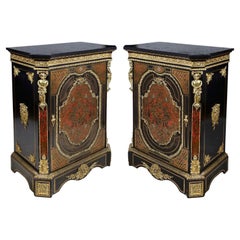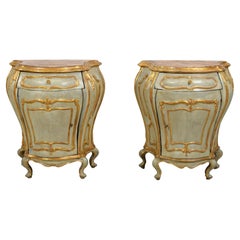Items Similar to Pair of 17th Century Spanish Baroque Gilt Bronze Mounted Cabinets on Stands
Want more images or videos?
Request additional images or videos from the seller
1 of 15
Pair of 17th Century Spanish Baroque Gilt Bronze Mounted Cabinets on Stands
$46,611.94
£34,200
€40,101.51
CA$64,305.22
A$71,510.07
CHF 37,558.64
MX$874,282.42
NOK 468,016.65
SEK 441,213.30
DKK 299,286.85
About the Item
An Exceptional and rare pair of 17th Century Spanish Baroque gilt bronze and metal mounted ebonised and tortoiseshell cabinets of grand scale with interesting provenance.
Spanish, circa 1680.
Provenance - purchased by Mr Stuart Fearnley of Rose Green Farm, Lindsey, Suffolk in the late 1930s at a country auction and thence by descent to the current owner.
The moulded top above a central door of architectural form with a niche and the standing classical figure of Athena flanked by dual pairs of Tuscan pillars, to the door reverse being segmented walnut and inlaid with ebonised geometric banding, opening to reveal five tortoiseshell and ebonised fronted drawers with gilt stars and ring handles, the bottom drawer concealing a further secret drawer to the rear. The portico being flanked by eight conforming drawers retaining steel locks and gilt escutcheons.The sides of the pieces have segmented walnut and inlaid geometric banding and ebonised mouldings together with iron drop carrying handles and they stand on gilt metal clad claw ebonised ball feet.
These cabinets, also known as Barguenos, have been meticulously conserved and are in exceptional condition. It is extremely rare to find a pair of these cabinet as often they are found alone. They sit upon a pair of of bespoke made steel stained designed specifically for these impressive cabinets.
The cabinet on stand with all its many variations became fashionable throughout Europe from the early 16 century. The design of these cabinets, with their rich ormolu mounts and tortoiseshell veneers set in an ebony frame, is typical of the work being produced not only in Spain but elsewhere in the Spanish empire at Naples and Antwerp during the 17th Century. This design of cabinet came to favour in Spain in the mid-17th century with the steady flow of fashions and ÈmigrÈ craftsmen from Germany and the low countries, and gradually superseded the earlier and more specifically Spanish form of cabinet on stand the vargueno.
Height of the cabinet 28 1/4 inches - 72cm
- Dimensions:Height: 64.18 in (163 cm)Width: 50.4 in (128 cm)Depth: 17.72 in (45 cm)
- Style:Baroque (In the Style Of)
- Materials and Techniques:
- Place of Origin:
- Period:Late 17th Century
- Date of Manufacture:Circa 1680
- Condition:Wear consistent with age and use.
- Seller Location:Benington, GB
- Reference Number:Seller: 30491stDibs: LU1183242648392
About the Seller
5.0
Gold Seller
Premium sellers maintaining a 4.3+ rating and 24-hour response times
Established in 1969
1stDibs seller since 2015
127 sales on 1stDibs
Typical response time: 5 hours
Associations
LAPADA - The Association of Arts & Antiques DealersThe British Antique Dealers' Association
- ShippingRetrieving quote...Shipping from: Benington, United Kingdom
- Return Policy
Authenticity Guarantee
In the unlikely event there’s an issue with an item’s authenticity, contact us within 1 year for a full refund. DetailsMoney-Back Guarantee
If your item is not as described, is damaged in transit, or does not arrive, contact us within 7 days for a full refund. Details24-Hour Cancellation
You have a 24-hour grace period in which to reconsider your purchase, with no questions asked.Vetted Professional Sellers
Our world-class sellers must adhere to strict standards for service and quality, maintaining the integrity of our listings.Price-Match Guarantee
If you find that a seller listed the same item for a lower price elsewhere, we’ll match it.Trusted Global Delivery
Our best-in-class carrier network provides specialized shipping options worldwide, including custom delivery.More From This Seller
View AllPair of Gilt Bronze Mounted 19th Century French Kingwood and Vernis Martin Petit
Located in Benington, Herts
A wonderful pair of gilt bronze mounted kingwood marble topped commodes with Vernis Martin painted panels, late 19th century.
Provenance...Cambridge, Esq.
Paris made circa 1880...
Category
Antique Late 19th Century French Commodes and Chests of Drawers
Materials
Marble
17th Century Japanese Lacquer Cabinet On French Giltwood Regence Stand
Located in Benington, Herts
An Extremely Fine and Very Important 17th Century Japanese Lacquer Cabinet on French Giltwood Stand of Regence Period circa 1680-1690
Provenance
Likely acquired by Herman Willem ...
Category
Antique 17th Century Japanese Edo Cabinets
Materials
Giltwood, Lacquer
Regency Amboyna And Ebony Inlaid Gilt Bronze Mounted Shaped Cabinet
Located in Benington, Herts
An early 19th Century Regency ormolu mounted amboyna and ebony shaped side cabinet on tapering legs. Outstanding quality.
In fine condition, the amboyna veneers having obtained a w...
Category
Antique 19th Century English Regency Cabinets
Materials
Ebony, Amboyna
Late 19th Century Gilt Bronze Mounted Tulipwood and Kingwood Marble Topped Comm
Located in Benington, Herts
An outstanding gilt bronze-mounted tulipwood, kingwood and sycamore parquetry breakfronted breche violet marble topped commode, in French Transitional style dating to the late 19th-e...
Category
Antique Late 19th Century French Neoclassical Commodes and Chests of Dra...
Materials
Marble
An Important Late 17th Century Japanese Lacquered Cabinet Edo Period on Stand
Located in Benington, Herts
An extremely fine, elegant and rare late 17th Century Japanese lacquer cabinet, from the Eco period, on later lacquered black stand.
Japanese circa 1690
Provenance
A private Scottish collection
This outstanding cabinet is a fascinating fusion of east and west. The cabinet itself would have been made in Japan, c.1690, and is decorated to the outside with hiramaki-e lacquer. This technique involves the use of sprinkled gold powder which adheres to the lacquer surface. On the best pieces, as with this example, many layers are added in order to create areas of high relief and give depth to the surface decoration. The taste of the Japanese workshops in this period was often for quite restrained pieces with plenty of the black background visible, unlike some of the busier Chinese lacquer or European japanned examples produced around the same time. The Japanese makers seemed content to rely on the outstanding quality of the lacquer itself, regarded by most experts as the finest lacquer ever produced, and did not see the need to cover every surface believing that less was more in this respect. The lacquer here is used to produce a mountainous scene with buildings on the bank of a river, the other side of the river with more buildings and a contrasting flatter and forested landscape. The fine perspective achieved is the result of the clever use of raised and flatter areas in the lacquer itself in combination with the drawing of the design itself.
Another remarkable aspect of this piece is the fine metalware throughout, but particularly the lockplate / hasp, hinges and foot mounts to the front. This is all beautifully cast and engraved contrasting against the black background. Interestingly another cabinet on stand with near identical metalwork was advertised in the Burlington Magazine, November 1913, with the dealer W. Williamson and Sons of Guildford. The lacquer on that piece is similarly refined and it seems likely that both pieces came from the same workshop.
The European influence in our piece can be seen in both the later ebonised stand and in the japanned decoration which has been applied to the inside of the doors and is also very fine indeed. This consists of two panels with birds of prey perched on branches in colours set against a golden background. The cabinet has a recent Scottish provenance and so it is likely that the ebonised stand was made in Britain though such pieces were made throughout Europe as a way of quite literally elevating these imported pieces of eastern lacquer as in Japan these would have been used on the floor. Inside the cabinet there is a combination of more Japanese lacquer and lock plates and European drawer handles. Most of the lacquer drawer fronts incorporate mountainous scenes and birds in combination, with a few purely one or the other of the two subjects. Again the lacquer is in excellent condition and is of exceptional quality with multiple layers of relief used in one single scene in many cases.
As mentioned above, Japanese lacquer is the most technically brilliant of the eastern lacquers and, as such, was highly prized by collectors and connoisseurs throughout Europe when this piece was made. The acquisition of such pieces would only have been possible for a small group of incredibly wealthy individuals, largely royal or high ranking courtiers or merchants connected with the East India trade...
Category
Antique 1690s Japanese Edo Cabinets
Materials
Lacquer
Extremely Rare Pair of Regency Cast-Iron Sarcophagus Shaped Strong Boxes
Located in Benington, Herts
An extremely rare pair of Regency cast-iron sarcophagus shaped strong boxes.
Regency, circa 1820
Painted to simulate palisander wood and with parcel-gilt, the cavetto-moulded hinged lids cast with flower sprays above foliate-cast bands over front panels relieved with river gods within canted corners cast with standing muses, the sides with lion mask and ring handles over leafy aprons on massive lion’s paw feet; the Brahmah type lock stamped “T. Davis from London” and impressed with the Royal Crown.
These extraordinary pieces are modelled on Regency wine coolers. The forms are classic Greco-Roman revival with the boat-hook handles, mythic figures and the overall sarcophagus pattern.
You would struggle to find one let alone a pair. Good items for any collection.
Research on going into these strong boxes but we have found possible information on the lock stamped Davis….(historyoflocks )
The relationship of King George III and George Davis of Windsor, who was locksmith in ordinary to His Majesty. Davis, in 1799, invented and patented a unique style of lock, which was also beautifully engraved with a warning not to make duplicate keys. Sensitive government secrets always demanded, then as today, locks that were state of the art. Davis locks ended up on government dispatch boxes...
Category
Antique Early 19th Century English Regency Commodes and Chests of Drawers
Materials
Iron
$21,704 Sale Price
35% Off
You May Also Like
Pair of 19th Century French Boulle Inlaid Side Cabinets
By André-Charles Boulle
Located in Brighton, Sussex
A very good quality pair of French late 19th century French Louis XVI style Boulle side cabinets, each with their original white marble tops, red ...
Category
Antique 19th Century French Louis XVI Cabinets
Materials
Tortoise Shell
Pair of 19th Century Boulle Pier Cabinets
By André-Charles Boulle
Located in Brighton, Sussex
A good quality pair of French 19th century Boulle side cabinets, having ebonized tops and sides, gilded ormolu mounts, glazed doors to each with r...
Category
Antique 19th Century French Louis XVI Cabinets
Materials
Brass
$10,903 / set
Pair 19th Century Boulle pier cabinets
By André-Charles Boulle
Located in Brighton, Sussex
Pair of French 19th Century Boulle inlaid side cabinets, each with their original black Belgium marble tops, gilded classical ormolu mouldings and mounts, canted corners with classic...
Category
Antique Late 19th Century French Louis XVI Cabinets
Materials
Belgian Black Marble
18th Century, Pair of Venetian Baroque Lacquered ang Gilt Wood Cabinet
Located in IT
18th Century, Pair of Venetian Baroque Lacquered ang Gilt Wood Cabinet
Measurements: cm W 72,5 x D 46 x H 82; Top cm W 60 (on the front W 45 cm) x D 36,5
This elegant pair of cabinets was made in Venice around the middle of the 18th century, in the Baroque period.
The wooden structure is entirely lacquered in shades of sugar paper blue with reserves and golden frames. The cabinets feature a lacquered wooden top in faux alabaster marble in bloom, of mixed and moved foma and edged by carved and gilded frame. On the front, they are accompanied by a drawer with a grip in gilded wood carved in shell shape. Below a door, which closes a large compartment, opens through a bronze handle with lock. The interior is entirely lacquered in blue. The cabinets have a particularly rounded structure, characteristic of the Venetian baroque furniture...
Category
Antique Mid-18th Century Italian Rococo Cabinets
Materials
Wood
Pair of 19th Century French Boulle Tortoiseshell Commodes
Located in Gloucestershire, GB
An exceptionally rare pair of small late 19th Century French boulle commodes.
The fronts with impressive premier-partie and contre-partie brass and tortoiseshell inlays.
With finely ...
Category
Antique Late 19th Century French Napoleon III Commodes and Chests of Dra...
Materials
Brass
Large Pair 19th Century French Boulle Cabunets
By André-Charles Boulle
Located in Brighton, Sussex
A large and impressive pair of 19th century French Boulle Tortoiseshell inlaid side cabinets, each with their original Belguim black marble tops, ...
Category
Antique Mid-19th Century French Commodes and Chests of Drawers
Materials
Belgian Black Marble, Brass
More Ways To Browse
Shell On Stand
Gilt Frame Baroque
Stand Claw
Secret Drawer
Spanish Baroque Frame
Antique Standing Scale
Spanish Empire
Niche Cabinet
Pillar Cabinet
Bronze Pillars
Green Steel Cabinet
Spanish Cabinet On Stand
Antique Bronze Door Handles
Ball And Claw Cabinet
1930s Metal Cabinet
Baroque Germany Cabinet
Antique Athena
Antique Bronze Kitchen Handles
